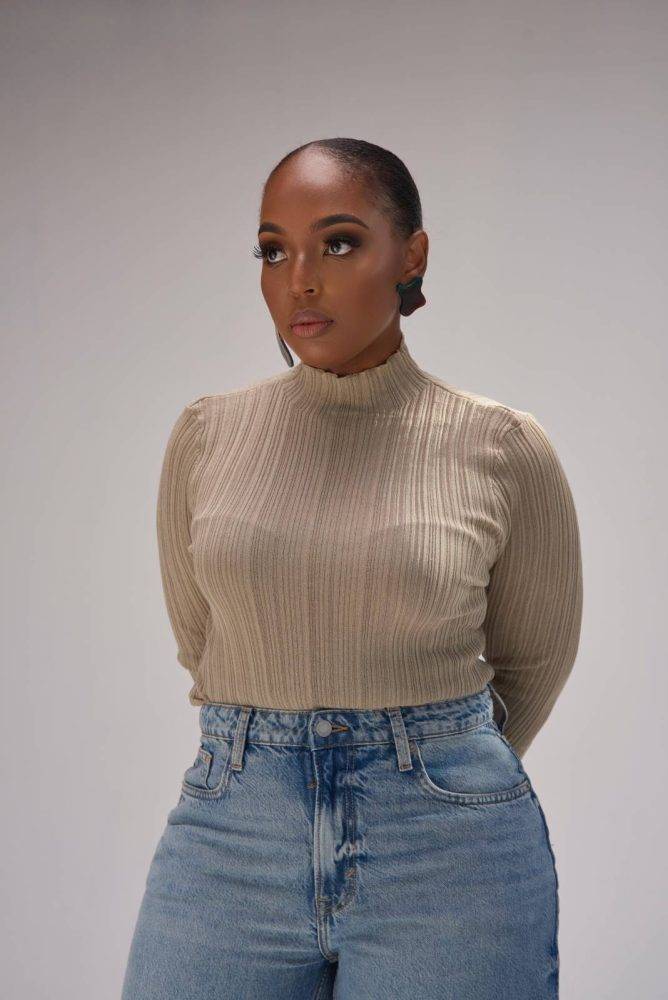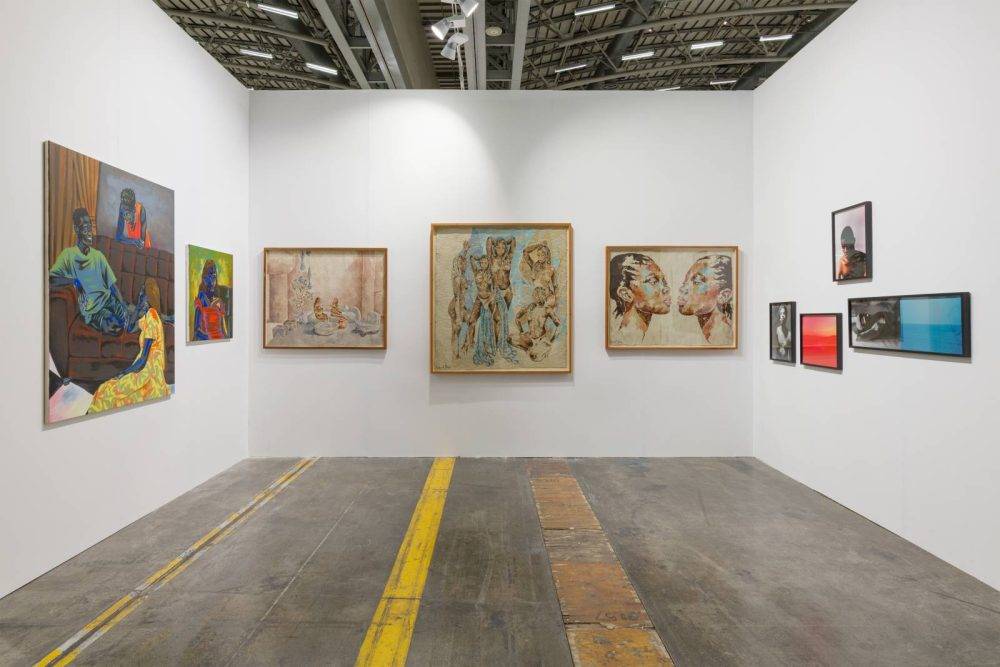
Anelisa Mangcu. (Photo by Zander Opperman)
Anelisa Mangcu’s journey in the art world was shaped by a rich family legacy, with creativity running deep in her bloodline.
As the great-granddaughter of George Pemba, the iconic South African social realist painter, Mangcu’s early exposure to the power of art sparked a lifelong passion.
“I was in the fortunate position of witnessing joy through art and the act of creating it up close. Like any kid, I was always quite naturally curious about it.”
Mangcu recalls taking all things art-related very seriously as a child, including theatre and dance. In high school, she started a photographic society and was asked to put together a team for the school magazine to document activities at Rustenburg Girls’ High School in Cape Town.
With the help of a teacher, she successfully applied for photography to be introduced as a subject at the school, leaving a legacy behind when she matriculated.
Mangcu went on to earn a degree in creative brand communications from the Vega School of Brand Leadership and later another in curatorship at the Centre for Curating the Archive at Michaelis School of Fine Art through an Andrew Mellon Foundation scholarship.
Ever the forward thinker, Mangcu was 19 when she hosted her first solo show — and sold a painting to former Miss South Africa Jo-Ann Strauss.
She has curated over 50 shows, including solo and group exhibitions and art fair presentations in museums and gallery spaces and at fairs.
Her gallery Under the Aegis, in Cape Town, was established in 2020. For the first three years it didn’t have a physical space but participated in art fairs and other initiatives.

Mangcu didn’t allow the limitations of space prevent her from pursuing her dream of having a physical gallery. It was only in May that a space was opened in Cape Town.
For her, curation is about care —guiding and supporting artists while investing deeply in their journeys.
This philosophy inspired the name Under the Aegis, reflecting both protection and leadership: “When someone is under the aegis of your curatorial direction, they’re under your care, guidance and leadership.”
She also wanted a name that felt distinct from her own identity. As one of the few black woman gallerists in South Africa, she could easily have named the space after herself, but chose instead to create something that would outlive her.
“I like to move in community, rather than with an individualistic mindset. Under the Aegis has a vision of its own — one that we all follow together.”
Mangcu reflected on a milestone year for Under the Aegis, highlighting its participation in major South African art fairs, including the Investec Cape Town Art Fair and RMB Latitudes Art Fair.
At Latitudes, the gallery won the best booth audience award — an especially meaningful achievement for Mangcu, as it marked her first time participating independently, rather than as an employee of another gallery.
The recognition extended beyond the space itself, as artist Buqaqawuli Thamani Nobakada, whose work was exhibited in their booth, received the 2023 audience choice ANNA award.
Following this success, Mangcu returned to Cape Town to collect the keys for Under the Aegis’s first physical space, spending the winter transforming it into a gallery that felt both inviting and true to the team’s vision.
The year also saw the gallery participate in FNB Art Joburg, completing a full circuit of local fairs.
However, last year, the focus shifted towards deepening the gallery’s programming, rather than continuing on the fair circuit.
“So, essentially, what I’m trying to say is we’re really moving at our own pace because it’s not a race.
“We’re all art practitioners with different goals and we’re fulfilling different needs and filling in gaps within the market in different ways.
“I think it’s always been important to kind of know who you are, know how you would like your establishment to be seen and how you want people to engage with it and maybe even the gap that you’re filling in, and play that role, and be adamant and very firm in it because there’s a piece of the pie for everyone.”
Mangcu emphasises the sense of community in the art world, noting that collaboration and support are more present than they might seem.
As a gallerist and curator, her focus is on showcasing remarkable exhibitions, securing institutional recognition for artists and ensuring their work finds a place in public and private collections.
“One thing that’s guaranteed is we will all have our time where we’re no longer physically on this earth but the artworks outlive us. They will outlive us. Stories will outlive us and people’s legacies will live through the works that they do.”
Beyond her gallery, Mangcu also established the company Victory of the Word with artist Athi-Patra Ruga as a vehicle to nurture emerging artists from the Eastern Cape.
Set in the Amathole Mountains of Hogsback, the residency provided eight artists with a space to explore their practice, develop new work and be mentored.
“It was very moving,” Mangcu says. “We put out a call for multi-disciplinary, contemporary artists to submit their vision and the response was incredible.”
After the residency, Bodyland: A Sight for Contemplation debuted at AVA Gallery, during the Cape Town Art Fair, bringing crucial visibility to the artists. The show later travelled to UJ Art Gallery, in Joburg.
“Seeing the response was the most beautiful thing ever,” she recalls. “It encourages us to do another residency when we’re in a position to fund it.”
Although the pandemic delayed further iterations, the residency’s impact endures. Many alumni have since exhibited at major art fairs, secured international residencies and gained gallery representation.
“That’s what we want,” Mangcu explains. “To give them the platform, the tools and then see them thrive. No one institution can fulfil everyone’s needs, so we count on the community to support and uplift each other.”
She acknowledges that keeping a business afloat in its first five years is a challenge, particularly in an unstable economy.
“Some people get lucky, some don’t,” she says, adding that political and social instability often means people prioritise essentials over art. Still, she remains optimistic.
“I’m very blessed that my collectors come in when I need them.”
She reflects on the broader industry, noting South Africa’s art market is shaped by historical and structural inequities: “If you do not come from the infrastructure of a very specific background, then you’re catching on to the bandwagon a little later.”
While this can make the space feel exclusionary, she believes perseverance and strategy can create access: “I don’t think anything is impenetrable if you put your mind and energy into it.”
Rather than dwell on challenges, she focuses on solutions — collaboration, mentorship and reimagining traditional gallery spaces.
“We have an opportunity to fill gaps, to do something better.”
She sees value in learning from established players.
“A lot of them do give energy and insight,” she says. “And that’s where I put my energy, rather than trying to work outside the system.”
This promises to be a defining year for Mangcu.
This month, she will curate the much-anticipated first institutional show for acclaimed Malawian-South African artist Billie Zangewa at the prestigious Norval Foundation in Cape Town. The exhibition, Breeding Ground, will not only showcase Zangewa’s work, but will include a special surprise.
This milestone marks a pivotal moment for Under the Aegis. The gallery will officially open its doors to the public with a full programme, including Buqaqawuli Thamani Nobakada’s debut solo exhibition. This dual launch embodies Mangcu’s commitment to nurturing artists and building a platform that champions both emerging talent and groundbreaking collaborations.
It’s testament to the gallery’s evolving role in South Africa’s vibrant art ecosystem, blending care, community and vision as it continues to thrive.



